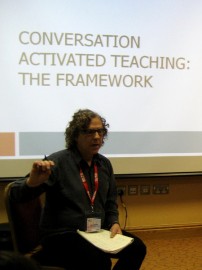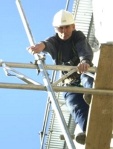 Three excellent presentations at IATEFL this year, each of which referenced Dogme, got me wondering.
Three excellent presentations at IATEFL this year, each of which referenced Dogme, got me wondering.
The first, Conversation-driven or dialogic methodology? ELT Classroom talk, was given by Dr Phil Chappell, from Macquarie University in NSW. Phil started out by asking the question: ‘If Dogme ELT is driven by conversation, yet natural conversation is not usually possible in the classroom, what kind of talk could best support its aims?’
Based on an extensive database of classroom interaction that he has amassed over time, Phil has identified five kinds of instructional classroom talk, two of which seem to approximate closely to the notion of conversation: discussion (defined as ‘the exchange of ideas with a view to sharing information and solving problems’), and inquiry dialogue. Inquiry dialogue is less about the exchange of ideas than the joint construction of ideas. It shares features with what Barnes (1976) called ‘exploratory talk’, which Mercer (1995: 104) describes as talk ‘in which partners engage critically but constructively with each other’s ideas… In exploratory talk knowledge is made more accountable and reasoning is more visible in the talk‘ (emphasis in original).
In comparing the two conversational modes, discussion and inquiry dialogue, Phil found that the former tends to be transmissive in style, involving the mere exchange of tokens of information or experience, with little in the way of follow-up, and which, in the interests of task completion, inclines towards early closure. As Phil put it: ‘The students are seated in groups, but they are not always working in groups.’
Inquiry dialogue, on the other hand, tends to be more open-ended, more tentative, and displays greater contingency, successive turns building on each other in a process of jointly-constructed ‘thinking aloud’. Because this talk revolves around playing with, and exploring, possibilities, it has been labelled wondering by some researchers (e.g. Lindfors 1999). Due to its collaborative and contingent nature, and because of the ongoing struggle to fit words to meanings in which the learners are heavily invested, this joint ‘wondering’ is, arguably, a prime site for language learning affordances, and hence a fertile source of ‘raw material’ in the Dogme classroom.
The second presentation that had me wondering was by Ken Lackman: CAT: A framework for Dogme. CAT stands for Conversation Activated Teaching and hence is consistent with the Dogme precept that teaching should be conversation-driven.
What Ken has devised (and what he engagingly demonstrated using his audience as pretend students) is a framework for constructing lessons that meet Dogme principles, but that at the same time provides novice (or nervous) teachers with a tight structure on which to map emergent language processing.
The demo lesson consisted of cycles of pairwork conversations (on a topic that had been selected by a class brainstorm and vote) alternating with similar conversations between the teacher and a selected student. As the teacher reformulated the guinea-pig student’s responses, and the observing students took notes, these ‘public’ conversations provided the ‘input’ for the subsequent closed pairwork stage. Key expressions were written on the board and their mechanics highlighted, in a way that replicates the language focus stage of Counselling Language Learning (CLL). The cycle of performed conversations, language focus and pairs practice can be repeated as often as time permits, allowing for optimal practice at ‘output + 1’.
In the light of Phil Chappell’s earlier presentation, however, my wondering took the form: ‘Could the same procedure be adapted for less transactional, and more exploratory talk? That is to say, could the goal of the conversations be less about exchanging travel experiences, say, and more about trying to explain why travel matters?’ My feeling is that it can, but I’d like to see this demonstrated.
Finally, Andrew Walkley’s talk, Language-focused teacher development, challenged the assumption (again, central to Dogme) that good teachers are well-equipped to deal with emergent language issues in ways that are non-trivial and challenging.
Andrew neatly demonstrated that many of our intuitions regarding the frequency of a word, or its most typical collocations, are flawed, to say the least. More importantly, he argued that teachers are ‘primed’ by traditional coursebook grammar syllabuses to see only (verb phrase) trees and no (lexical) wood. Hence, when it comes to reformulating learner utterances, we/they seldom provide the kind of productive co-textual data that a corpus search or even a well-written coursebook (like one of Andrew’s, presumably) might deliver. Using the example of the word ‘efficient’, he showed that a Google search for ‘efficient’ throws up many texts of the type ‘X [service, product etc] was very efficient. I had a problem but X sorted it out’. Andrew argued that the reactive teacher would be unlikely to link ‘efficient’ with the phrase ‘sorted it out’ in an off-the-cuff reformulation in the context of, say, one of Ken Lackman’s performed conversations.
I have to agree, although I think that the ability to think ‘outside the grammar box’ can be trained, by, for example, repeatedly unpacking texts for the constructions that they house (see C is for Construction for an example). The deft use of reference tools, such as learner dictionaries or online corpora, can also be developed. And, of course, teachers who (luckily?) have never used a coursebook are perhaps less prone to see everything through the prism of pedagogical grammar anyway. In the end, though, teachers will get better at reformulating effectively only if they realise that the success of their teaching depends on it. (And this, surely, is a skill that should be developed in all teachers-in-training, whether Dogme-inclined or not).
So, in the light of these three presentations, what (I wonder) might a more rigorous model of Dogme look like? Perhaps it would have the tight, reiterative methodology of Lackman’s CAT framework, but adapted to the wondering conversations favoured by Chappell, while – following Walkley’s example – the reformulation stage would gather in, not just sentence grammar features, but lexical, co-textual and generic ones as well.
Why not just use a coursebook? There are so many ways I could answer that question, but space doesn’t allow. Suffice it to quote the very quotable John Holt (1967: 124):
It can’t be said too often: we get better at using words, whether hearing, speaking, reading, or writing, under one condition and only one—when we use those words to say something we want to say, to people we want to say it to, for purposes that are our own.
References:
Barnes, D. (1976) From Communication to Curriculum, London: Penguin.
Holt, J. (1967) How Children Learn, London: Penguin.
Lindfors, J.W. (1999) Children’s Inquiry: Using language to make sense of the world, New York, NY: Teachers College Press.
Mercer, N. (1995) The Guided Construction of Knowledge: Talk amongst teachers and learners, Clevedon: Multilingual Matters.















Recent comments